Designing a Space Efficient Living Dining Room: 15 Combined Living and Dining Room Ideas
Designing a combined living and dining room can be tricky, especially if you want to make the most out of a small space. But don’t worry! With some smart ideas, you can create a room that looks great and works well for both relaxing and eating. Here’s a simple guide to help you design a space-efficient combined living and dining area.
Why Combine Living and Dining Rooms?
Many homes have limited space, so combining the living room and dining room helps save space and makes the home feel bigger. It also allows family members to spend more time together.
Key Tips to Design Your Combined Living and Dining Room
1. Choose the Right Furniture
- Multi-purpose furniture: Use pieces that can serve more than one purpose, like a sofa bed or a dining table that can be folded or extended.
- Smaller scale: Pick smaller sofas, chairs, and tables that fit well without overcrowding the room.
2. Use Zones to Separate Spaces
Even though the living and dining rooms are combined, you can create separate zones.
- Rugs: Place different rugs under the dining table and sofa to define each area.
- Lighting: Use different types of lighting in each zone (like a chandelier over the dining table and floor lamps in the living area).
3. Keep the Layout Open
An open layout makes the room feel larger.
- Arrange furniture in a way that allows easy movement.
- Avoid bulky furniture that blocks pathways.
4. Use Vertical Space
- Shelves: Install shelves on walls to store books, decorations, or dishes.
- Tall cabinets: These store things without taking up much floor space.
5. Select Light Colors
Light colors on walls and furniture make a room look brighter and more spacious.
Sample Layout Ideas
| Living Area | Dining Area |
|---|---|
| Sofa against one wall | Small dining table with chairs |
| Coffee table with storage | Pendant lights above table |
| TV mounted on wall | Rug under dining table |
Simple Checklist for Your Design
- Pick furniture that fits your space
- Create clear zones with rugs and lighting
- Keep pathways open for easy movement
- Use shelves or tall cabinets for storage
- Choose light colors for walls and furniture
15 Combined Living and Dining Room Ideas for Small Spaces
If you want to see specific examples and clever tricks to make your living-dining room work perfectly. This next part will give you plenty of ideas that are easy to follow and perfect for making your space look amazing.
Choose a Unified Color Palette

When you choose a unified color palette, you’ll establish a cohesive look that ties your living and dining areas together.
Understanding color psychology helps you select hues that evoke desired emotions, while ensuring color harmony creates visual balance.
Stick to a few complementary shades to maintain flow, making your space feel inviting and connected, enhancing both functionality and aesthetics in your home.
Incorporate Similar Textures
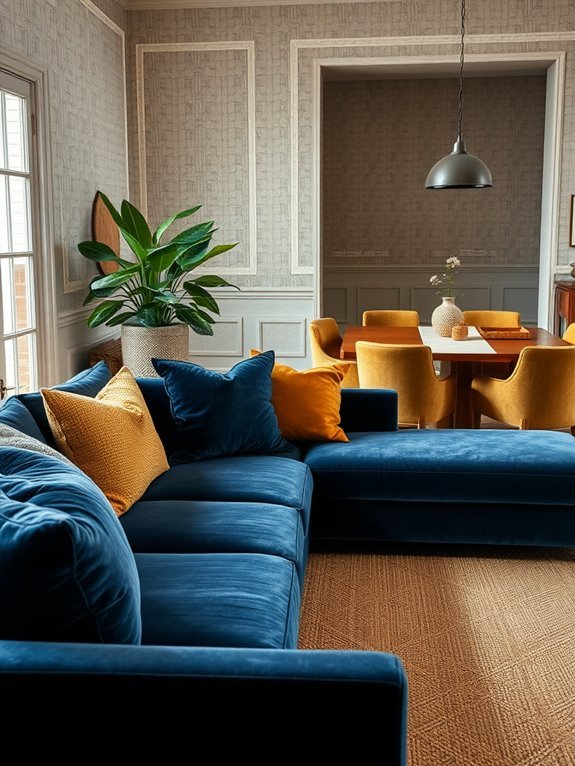
To create a seamless changeover between your living and dining areas, incorporating similar textures can make a significant difference.
Opt for materials like woven fabrics, smooth woods, or soft leathers to establish tactile harmony.
While you can play with texture contrast through accents, keeping a unified texture theme helps maintain flow, making your spaces feel connected and inviting.
Use Matching Furniture Styles

Using matching furniture styles is essential for creating a cohesive look between your living and dining areas.
By selecting pieces that share similar furniture aesthetics, you’ll achieve style consistency that ties the two spaces together.
Whether you opt for modern, rustic, or classic designs, matching styles will enhance the overall flow, making your home feel harmonious and inviting.
Create Defined Zones

Creating defined zones in your living and dining areas not only enhances functionality but also adds visual interest.
Use zoning techniques, like strategically placing furniture, to create distinct spaces for relaxation and dining. Room dividers, such as bookshelves or curtains, can further delineate areas, providing privacy and separation.
This approach helps maintain a cohesive look while allowing each zone to shine.
Hang Coordinated Artwork

Hanging coordinated artwork can transform your living and dining spaces, tying the two areas together seamlessly.
Choose artwork arrangements that complement each other, focusing on themes, colors, or styles that resonate throughout both rooms.
Experiment with different frame styles to add depth and interest.
Select Complementary Lighting

While selecting lighting for your living and dining rooms, consider how different fixtures can enhance the ambiance and functionality of each space.
Use ambient lighting for warmth, task lighting for functionality, and decorative fixtures for style.
Opt for energy-efficient materials, explore dimmable options, and choose the right color temperature.
Smart lighting can also help you control accent lighting and optimize lighting placement.
Layer Rugs for Depth

Layering rugs can instantly add depth and character to your living and dining spaces.
Use layering techniques like combining a larger neutral rug with a smaller patterned one to create visual interest.
Experiment with different rug materials, such as a jute base topped with a soft wool or cotton piece.
This not only enhances texture but also defines separate areas within your open space.
Incorporate Greenery
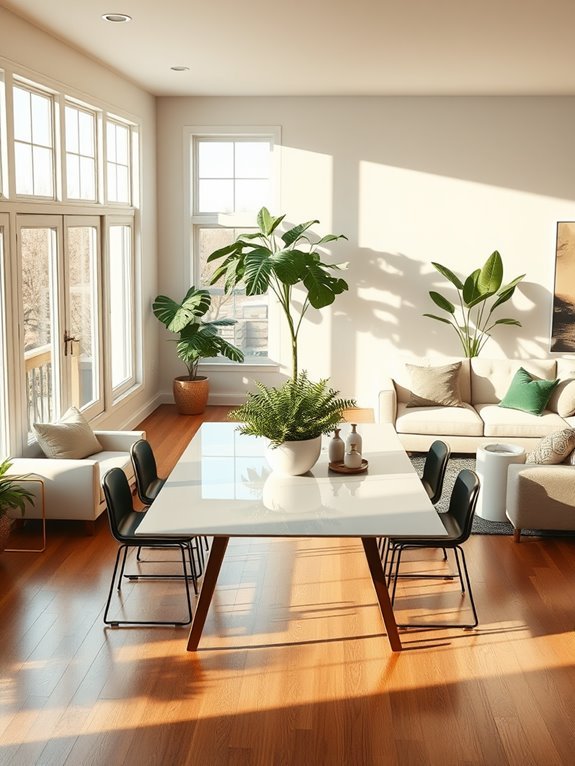
Adding greenery to your living and dining spaces can enhance the layered look created by your rugs.
Choose plants that fit your style and space, focusing on your plant selection for both aesthetics and maintenance.
Indoor gardening can be a fun hobby, so consider low-light options like snake plants or pothos for easy care.
They’ll breathe life into your rooms and create a cohesive atmosphere.
Use Open Shelving for Display

How can you make your living and dining room feel more spacious and stylish? Open shelving is a fantastic choice! It showcases your personality while keeping things airy.
Consider these shelving styles for your display arrangements:
- Minimalist wooden shelves
- Colorful floating shelves
- Industrial metal shelving
These options not only enhance your decor but also create an inviting atmosphere perfect for entertaining.
Pick a Statement Piece
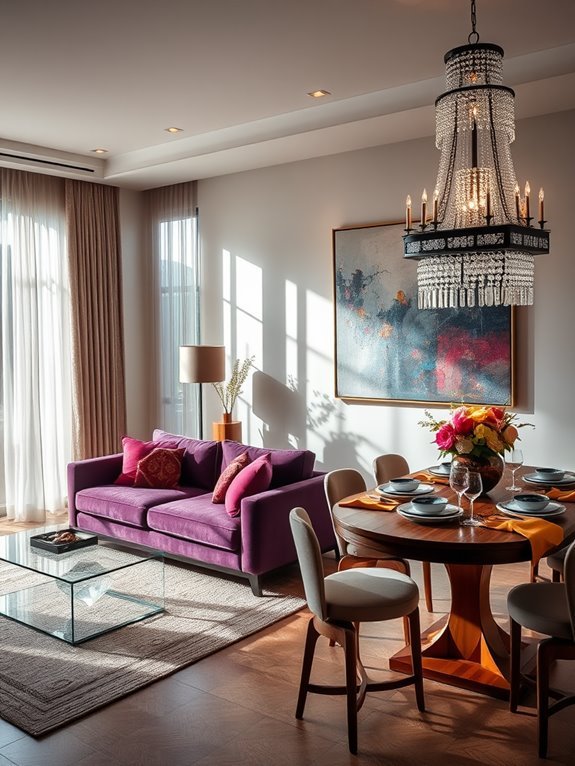
While you’re curating your living and dining space, selecting a statement piece can truly transform the ambiance.
Choose an item that features bold colors or unique shapes to draw the eye and create a focal point.
Whether it’s a vibrant painting or an eye-catching sculpture, this piece will anchor your design and effortlessly tie both areas together, enhancing your overall aesthetic.
Balance Scale and Proportion
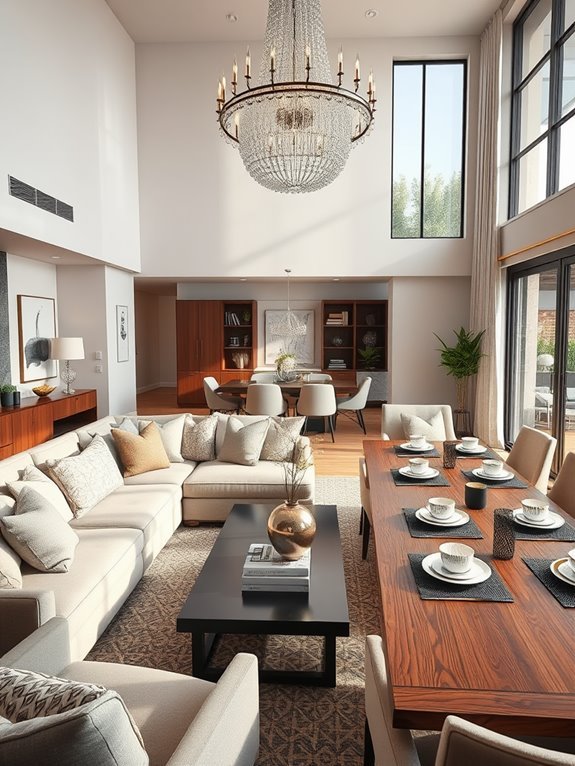
Achieving balance in scale and proportion is essential for creating a harmonious living and dining space.
To guarantee scale harmony and proportion balance, consider these elements:
- Match furniture size to room dimensions for visual comfort.
- Use varying heights in decor for dynamic interest.
- Choose color schemes that unify both areas.
These tips help you create a cohesive look that feels inviting and balanced.
Integrate Functional Decor

Creating a balanced living and dining area sets the stage for integrating functional decor that enhances both style and usability.
Choose multi-purpose furnishings, like a stylish coffee table that doubles as storage or a dining bench that offers extra seating.
Incorporate functional accessories, such as decorative trays or baskets, to keep essentials organized while adding visual appeal.
This approach guarantees your space remains practical and inviting.
Utilize Mirrors for Space
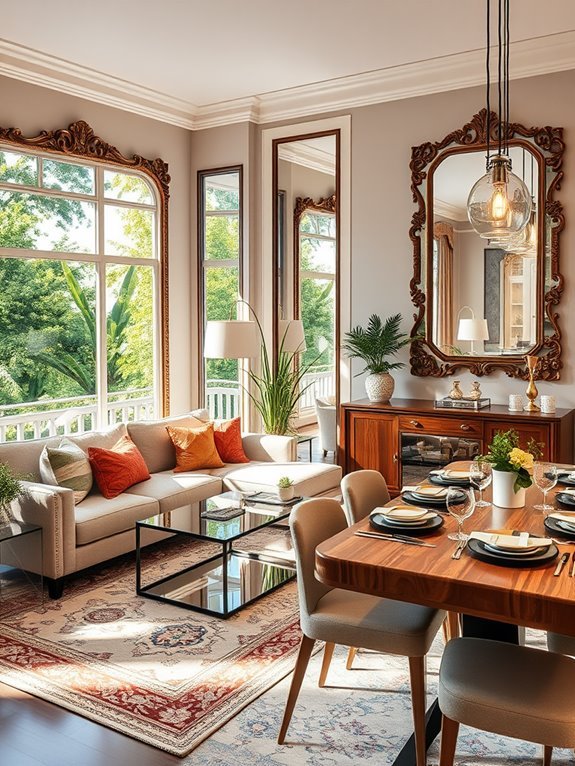
Mirrors can transform your living and dining space by making it feel larger and more open.
By strategically using mirror placement, you can enhance the natural light and create an inviting atmosphere.
Consider these ideas:
- Hang a large mirror opposite a window for maximum light reflection.
- Use mirrored furniture to add depth.
- Place smaller mirrors in clusters for visual interest.
Reflective surfaces truly elevate your decor!
Create a Focal Point

A well-placed focal point can draw attention and add character to your living and dining spaces, much like how mirrors enhance light and openness.
Consider focal point options like a striking piece of artwork or a bold piece of furniture.
Use color contrast to make these elements pop, ensuring they stand out and create visual interest while tying your spaces together.
Personalize With Accessories
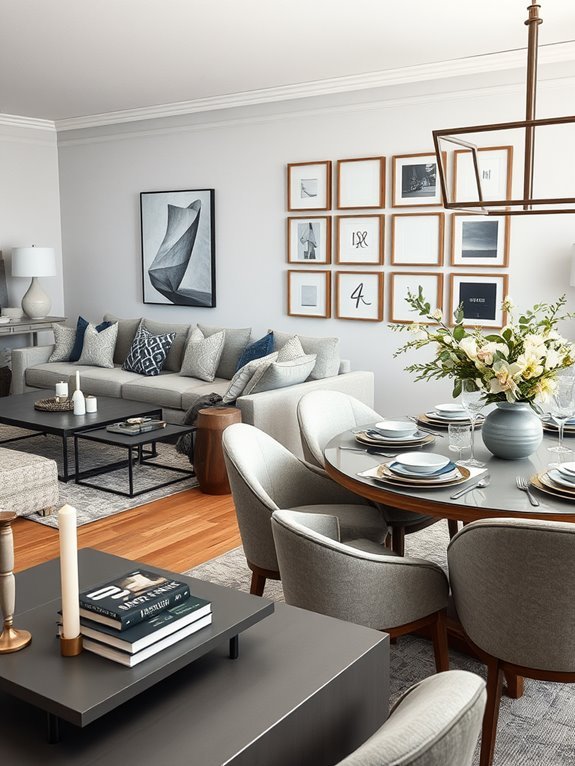
While you might think furniture is the main element in your living and dining room, accessories play an essential role in adding your personal touch.
Use curated collections to showcase your style.
Consider incorporating:
- Unique artwork that reflects your personality
- Decorative pillows in vibrant colors
- A stylish vase filled with fresh flowers
These personal touches create a warm, inviting atmosphere that feels authentically yours.
Conclusion
So there you have it—your guide to living and dining room harmony! Just remember, if you ignore these tips, you might end up with a space that looks like a thrift store explosion. Who needs a cohesive look when you can have a chaotic blend of styles? But seriously, stick to a unified palette and those matching textures, and your home will thank you. After all, nobody wants to dine surrounded by a circus of clashing decor!
